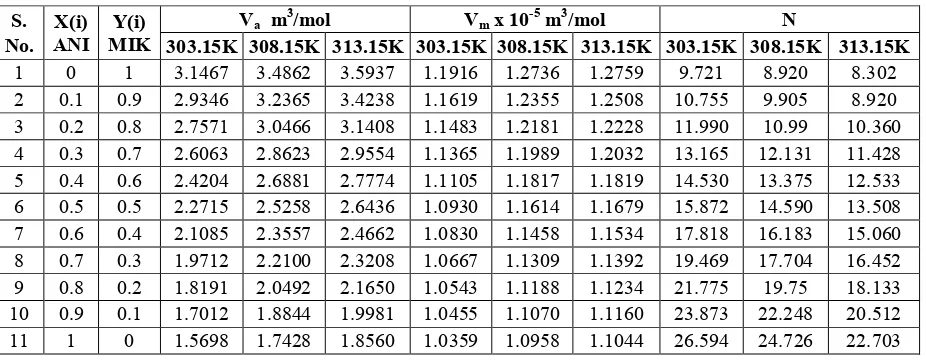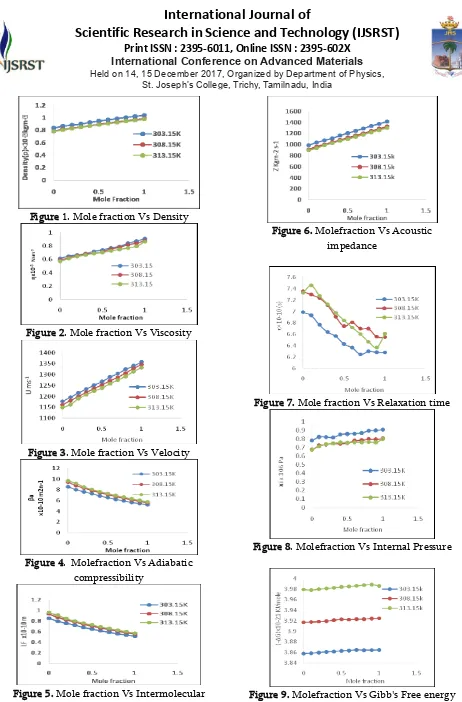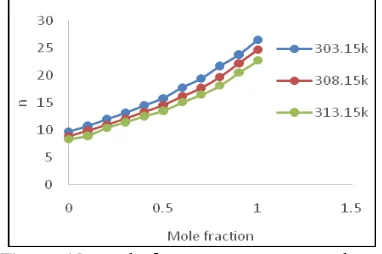Investigation of Molecular Interactions in Binary Mixtures of Anisole
with Methyl Isobutyl Ketone at Different Temperatures
D.Devi1, M. M. Armstrong Arasu2, A.Mary Girija3
1Assistant Professor, Department of Physics, Cauvery College for Women, Trichy-18, Tamilnadu, India
2Assistant Professor, Department of Physics, St. Joseph’s College (Autonomous) Trichy-02, Tamilnadu,
India
3Assistant Professor, Department of Physics, Cauvery College for Women, Trichy-18, Tamilnadu, India
Corresponding author E-mail address: armstrongarasu@gmail.com
Abstract
The ultrasonic velocity(U), density (ρ) and viscosity (η) of pure solvents and binary mixtures of Anisole and Methyl Isobutyl Ketone have been investigated at three different temperatures 303.15K, 308.15K and 313.15K and correlated with concentration. The observed data have been used to evaluate some of the thermo acoustical parameters such as adiabatic compressibility (βa), intermolecular free length (Lf), internal pressure (πi), acoustic
impedance (Z), available volume (Va), relaxation
time (τ), molar volume (Vm) and Gibb’s free energy
(∆G), Lennard Jones potential repulsive term exponent(n) to elucidate the molecular association in the mixture. The variation of these parameters with concentration of solute indicates the nature of interaction present in the binary mixture.
Keywords: Anisole, Ultrasonic velocity, adiabatic compressibility, acoustic impedance, molecular association.
Introduction
The study of molecular interactions in liquid mixture provides valuable information regarding internal structure, molecular association, Internal pressure and complex formation. The propagation of ultrasonic waves in liquid is a tool by researcher to probe into the properties of liquids [1-3]. The measurement of ultrasonic velocity in liquid
mixtures have greater importance in predicting the physico-chemical properties of liquid mixtures.
In the present study, the density, ultrasonic velocity and viscosity were measured for the binary system of Anisole and Methyl isobutyl Ketone at various temperatures. Anisole is an organic
compound with the formula C7H8O. It is a
colourless liquid and its derivatives are found in natural and artificial fragrances insoluble in water. It is used as a precursor to perfumes and pharmaceuticals. The second component is Methyl isobutyl Ketone, it is a colourless liquid with the
formula C6H12O. It is a ketone, used as a solvent for
gums, varnishes and nitrocellulose. These liquids have been chosen on the basis of their industrial applications. These applications stimulated the need for extensive information on the thermodynamic and acoustic properties of these mixtures.
Results are used to explain the nature of molecular interactions between mixing Compounds.
2. Experimental Section
The mixtures of various concentrations in mole fraction were prepared by taking analytical reagent grade chemicals with minimum assay of 99.9% and obtained from E. Merck Ltd (India). All the component liquids were purified by the standard methods. The density, viscosity, and ultrasonic velocity were measured as a function of concentration of the binary liquid mixture at 303.15K, 308.15K & 313.15K. Ultrasonic velocity measurements were made using an ultrasonic interferometer with the accuracy of ±0.1m·s−1. An electronically operated digital constant temperature bath operating with an accuracy of ±0.1°C has been used to circulate water through the outer jacket of the double-walled measuring cell containing the experimental liquid. The densities of the mixture were measured using a 10-ml specific gravity bottle by relative measurement method with an accuracy of ±0.01 kg·m−3. An Oswald viscometer (10 ml) with an accuracy of ±0.001 Ns·m−2 was used for the viscosity measurement. The flow time was determined using a digital racer stopwatch with an accuracy of ±0.1s.
Theory
The various thermo acoustical parameters were determined using the following equations [5-11]
Adiabatic Compressibility (βa):
βa = 1/ (U2*ρ) (1)
Intermolecular Free Length (Lf):
Lf = KJ (βa)1/2 (2)
where KJ is the temperature dependent Jacobson’s
constant but independent of the nature of liquid.
Free Volume (Vf)
Vf = [(Meff U) / (K η)] 3/2 (3)
where, Meff (Effective mass) = Σ mixi, in which mi and xi are the molecular weight and the mole fraction of the individual constituents respectively.
K is the temperature independent constant, which is equal to 4.28 *109 for all liquids and η be the viscosity.
Internal Pressure (πi)
πi=(bRT)[(K*η)/(U)]½*[(ρ2/3)/(Meff7/6)] (4)
where, b is the cubic packing which is assumed to be 2 for all liquids and solutions, K is the temperature independent constant ,T is the absolute temperature, R is universal gas constant.
Relaxation Time (τ)
Relaxation time (τ) is the time taken for the excitation energy to appear as translational energy and it depends on temperature and on impurities. The dispersion of ultrasonic velocity in binary
mixture reveals information about the
characteristic time of the relaxation process that causes dispersion.
τ = (4/3) βa* η (5)
Acoustic Impedance (Z)
Z = U*ρ (6)
Gibb’s Free Energy (ΔG)
The relaxation time for a given transition is related to the activation energy. The variation of relaxation time (τ) with temperature (T) can be expressed in the form of Eyring self-process theory.
ΔG = (KBT)log [(KBTτ)/h] (8)
where KB is the Boltzmann’s constant (1.3806 × 1023
Jk-1), h is the plank’s constant 6.63*10-34 JS), T be the absolute temperature and τ be the relaxation time.
Va = (Meff/ρ)(1-(U/U∞)) (10)
Lennard Jones Potential Repulsive Term Exponent (n)
n = (6Vm/VA)-13 (11)
Molar Volume (Vm)
Vm = Meff/ρ (12)
Results and Discussion
Table 1. Measured Values of Density (ρ), Viscosity (η) and velocity (U) of binary mixture of Anisole with Methyl Isobutyl Ketone at 303.15K, 308.15K & 313.15K
S.
No. ANI X(i) MIK Y(i) ρ x 10
-3 kgm-3 η x 10-3 Nsm-2 U
ms-1
303.15K 308.15K 313.15K 303.15K 308.15K 313.15K 303.15K 308.15K 313.15K
1 0 1 0.8405 0.7864 0.7850 0.6103 0.5853 0.5695 1177.5 1162.0 1149.3
2 0.1 0.9 0.8689 0.8171 0.8071 0.6459 0.6231 0.6093 1195.8 1180.8 1162.5
3 0.2 0.8 0.8861 0.8353 0.8321 0.6645 0.6523 0.6417 1215.8 1199.8 1189.5
4 0.3 0.7 0.9023 0.8554 0.8523 0.6830 0.6764 0.6634 1233.1 1218.2 1207.1
5 0.4 0.6 0.9306 0.8746 0.8744 0.7175 0.6919 0.6852 1251.3 1236.1 1224.3
6 0.5 0.5 0.9528 0.8967 0.8917 0.7380 0.7106 0.7012 1267.5 1252.5 1237.8
7 0.6 0.4 0.9690 0.9159 0.9099 0.7680 0.7554 0.7252 1288.5 1271.0 1257.8
8 0.7 0.3 0.9913 0.9350 0.9282 0.7904 0.7784 0.7459 1304.3 1287.3 1274.0
9 0.8 0.2 1.0105 0.9523 0.9484 0.8370 0.8168 0.7671 1323.9 1306.9 1291.6
10 0.9 0.1 1.0267 0.9696 0.9618 0.8685 0.8401 0.7924 1339.6 1327.6 1313.5
11 1 0 1.0439 0.9868 0.9791 0.9065 0.8776 0.8599 1357.5 1345.5 1331.1
Table 2.Values of Adiabatic compressibility (βa), Intermolecular free length (Lf), Acoustic
impedance (Z) at 303.15K, 308.15K & 313.15K
S.
No. ANI X(i) MIK Y(i)
βa x 10-10 m2n-1 LF x 10-10 m KgmZ -2 s-1
303.15K 308.15K 313.15K 303.15K 308.15K 313.15K 303.15K 308.15K 313.15K
1 0 1 8.5810 9.4168 9.6434 0.8495 0.9322 0.9547 989.68 913.8 902.2
2 0.1 0.9 8.0473 8.7763 9.1753 0.7966 0.8688 0.9083 1039.1 964.8 937.6
3 0.2 0.8 7.6340 8.3157 8.5001 0.7557 0.8232 0.8415 1077.3 1002.2 989.4
4 0.3 0.7 7.2887 7.8800 8.0535 0.7215 0.7801 0.7972 1112.6 1041.8 1028.2
5 0.4 0.6 6.863 7.4839 7.6331 0.6794 0.7409 0.7556 1164.4 1081.0 1070.1
6 0.5 0.5 6.5328 7.1139 7.3188 0.6467 0.7042 0.7245 1207.6 1122.7 1103.8
7 0.6 0.4 6.2159 6.7581 6.9458 0.6153 0.6690 0.6876 1248.5 1164.1 1144.7
8 0.7 0.3 5.9294 6.4536 6.6372 0.5870 0.6389 0.6570 1292.9 1203.6 1182.3
9 0.8 0.2 5.6458 6.1477 6.3200 0.5589 0.6086 0.6256 1337.8 1244.5 1225.0
10 0.9 0.1 5.4271 5.8511 6.0259 0.5372 0.5792 0.5965 1375.4 1287.2 1263.1
11 1 0 5.1979 5.5972 5.7641 0.5146 0.5541 0.5706 1417.1 1327.7 1303.6
Table 3. ∆G) at
303.15K,308.15K&313.15K
S. No.
X(i) ANI
Y(i) MIK
τ× 10-10 (s) π
i x106 Pa (-∆G)x10
-21
KJ/mole
303.15K 308.15K 313.15K 303.15K 308.15K 313.15K 303.15K 308.15K 313.15K
1 0 1 6.9826 7.3489 7.3226 0.7812 0.6755 0.6729 3.8575 3.9168 3.9795
2 0.1 0.9 6.9304 7.2913 7.4540 0.8229 0.7227 0.7120 3.8580 3.9173 3.9784
3 0.2 0.8 6.7638 7.2325 7.2726 0.8196 0.7364 0.7372 3.8595 3.9178 3.9800
5 0.4 0.6 6.5656 6.9042 6.9736 0.8505 0.7455 0.7573 3.8614 3.9208 3.9827
6 0.5 0.5 6.4283 6.7402 6.8426 0.8579 0.7529 0.7551 3.8627 3.9223 3.984
7 0.6 0.4 6.3651 6.8067 6.7162 0.8611 0.7797 0.7586 3.8633 3.9217 3.9852
8 0.7 0.3 6.2488 6.6979 6.6009 0.8689 0.7840 0.7603 3.8645 3.9227 3.9863
9 0.8 0.2 6.3007 6.6952 6.4641 0.8937 0.7975 0.7639 3.8640 3.9228 3.9877
10 0.9 0.1 6.2846 6.5540 6.3666 0.8979 0.7945 0.7574 3.8641 3.9241 3.9887
11 1 0 6.2826 6.5495 6.6088 0.9078 0.8054 0.7980 3.8642 3.9242 3.9862
Table 4. Values of Available volume (Va), Molar volume(Vm), Lennard Jone Potential repulsive
exponent (n) at 303.15K, 308.15K & 313.15K
S.
No. ANI X(i) MIK Y(i)
Va m3/mol Vm x 10-5 m3/mol N
303.15K 308.15K 313.15K 303.15K 308.15K 313.15K 303.15K 308.15K 313.15K
1 0 1 3.1467 3.4862 3.5937 1.1916 1.2736 1.2759 9.721 8.920 8.302
2 0.1 0.9 2.9346 3.2365 3.4238 1.1619 1.2355 1.2508 10.755 9.905 8.920
3 0.2 0.8 2.7571 3.0466 3.1408 1.1483 1.2181 1.2228 11.990 10.99 10.360
4 0.3 0.7 2.6063 2.8623 2.9554 1.1365 1.1989 1.2032 13.165 12.131 11.428
5 0.4 0.6 2.4204 2.6881 2.7774 1.1105 1.1817 1.1819 14.530 13.375 12.533
6 0.5 0.5 2.2715 2.5258 2.6436 1.0930 1.1614 1.1679 15.872 14.590 13.508
7 0.6 0.4 2.1085 2.3557 2.4662 1.0830 1.1458 1.1534 17.818 16.183 15.060
8 0.7 0.3 1.9712 2.2100 2.3208 1.0667 1.1309 1.1392 19.469 17.704 16.452
9 0.8 0.2 1.8191 2.0492 2.1650 1.0543 1.1188 1.1234 21.775 19.75 18.133
10 0.9 0.1 1.7012 1.8844 1.9981 1.0455 1.1070 1.1160 23.873 22.248 20.512
Figure 1. Mole fraction Vs Density
Figure 2. Mole fraction Vs Viscosity
Figure 3. Mole fraction Vs Velocity
Figure 4. Molefraction Vs Adiabatic compressibility
Figure 5. Mole fraction Vs Intermolecular free length
Figure 6. Molefraction Vs Acoustic impedance
Figure 7. Mole fraction Vs Relaxation time
Figure 8. Molefraction Vs Internal Pressure
Figure 10. Mole fraction Vs Available volume
Figure 11. Molefraction Vs Molar volume
Figure 12. Mole fraction Vs LJP Repulsive term
Results and Discussion
The experimental values of density, velocity and viscosity at three different temperatures for the binary mixture were used to calculate the acoustical and thermos dynamical parameters and the relevant data are presented in Tables 1 to 4. The variation of these parameters are displayed graphically in Figures 1-12.
Density is a parameter giving information about solvent-solvent interactions. From the Table 1and Figure1 it is observed that in all the three temperatures the density and velocity increases with increasing mole
fraction and decreases with higher
temperatures. The increase in density indicates the presence of solvent-solvent interactions in the binary mixture which may bring a bonding between them [11]. Figure3 Shows that ultrasonic velocity increases with mole fraction and decreases with temperature. The structural changes occurring in the mixture with the increase in mole fraction leads to increase in velocity which may result in the increase in intermolecular forces. From Table1 and Figure 2, it is found that the viscosity of all liquid mixtures were found to be increased with increasing concentration of Anisole. Due to the increase of Anisole molecules in solution, the medium became denser. Further, the increase in the number of particles in solution is responsible for increasing the cohesive force between the liquid layers. Thereby, the co-efficient of viscosity increases in all systems.
The variation of adiabatic compressibility
(βa), Intermolecular free length (Lf) and
acoustic impedance (Z) with the increase in mole fraction are presented in Table 2. Based on the model for sound propagation proposed by Eyring and Kincaid [11], ultrasonic velocity should increase, if the intermolecular free length decreases and vice
versa. A reduction in adiabatic
other. The intermolecular free length (Lf) is the distance covered by a sound wave between the surface of the neighbouring molecules and it depends upon the intermolecular attractive and repulsive forces. The decrease in the value of adiabatic
compressibility (βa) and Intermolecular free
length (Lf) with concentration further strengthens the strong molecular association between the unlike molecules through hydrogen bonding.
The increase in the value of Lf with
temperature implies that the mean distance between the molecules increases thereby
decreasing the potential energy of
interaction between them, leading to the decrease in the values of velocity and density. Molecular association increases the acoustic impedance (Z). It is the opposition exerted by the medium to displacement of the mediums particles by sound energy. A continuous decrease in (βa), Lf and increase of Z with concentration are the clear evidence for the existence of strong interactions like dipole-dipole and dipole induced dipole interaction.
The relaxation time decreases with increase in concentration, is due to the structural relaxation process and in such a situation, it is suggested that the molecule get rearranged due to co-operative process. The Gibb’s free energy increase with increasing temperature may be due to the dissociation of intermediate compound between binary liquids. It is observed that free energy increase favours the dissociation of products from reaction.
Internal pressure in a liquid system is a measure of intermolecular cohesive forces [16]. From the Table 3, it is observed that as the mole fraction of Anisole increases, free volume decreases whereas internal pressure increases. This suggests the close packing of the molecule inside the shield, which may be brought about by the increasing magnitude of interactions. [17,18].
It can be observed that the molar volume
Vm decreases with increase in concentration of
Anisole. This is because of the fact, that molecular weight is directly proportional to the molar volume. Moreover, molar volume increase with rise in temperature in our study, which probably from the fact that thermal energy facilitates an increase in the molecular separation in the liquid mixtures and thus leads to an increase in molar volume.
Table 4 and Figure 11 shows that the
available volume Va decreases with the increase
in molefraction of Anisole. Available volume is a direct measure of compactness and strength of bonding between the molecules of the liquid mixture. [14]. The decrease in Va is due to the net packing of molecules inside the shell which may be formed by complexation between unlike molecules through hydrogen bonding in the binary mixture.
Lennard-Jones potential φ(r) is given by the relation [17].
φ(r) = -Ar-6 + Dr-n
attractive forces while the second term arises from repulsive forces. Larger the value of n smaller is the second term. Thus large value of n indicates the dominance of attractive forces over repulsive forces. The values of n increase with the increase in mole fraction of Anisole as shown in Table 4 and Figure 12 for a fixed frequency. The increase in n indicates the increasing dominance of attractive force over repulsive forces in the binary liquid mixture. Further, the values of n decrease with the increase in temperature for a particular concentration which indicates the increase in repulsive forces due to reduction in molecular interaction in the binary mixture [18].
Conclusion
The ultrasonic method was found to be a powerful tool in characterizing the physico-chemical behavior of liquid mixtures. It is concluded from the experimental and calculated parameters that the density, viscosity, velocity increases with increase in mole fraction of Anisole. This is due to the dipole induced dipole interaction between the binary mixture. The temperature variation indicates that the strength of intermolecular
interaction decreases with rise in
temperature.
References
[1] K. Dash and R. Paikaray, “Acoustical
study in binary liquid mixture
containing dimethyl acetamide using ultrasonic and viscosity probes”, Der Chem. Sinica, vol. 5, no. 1, (2014), pp. 81-88.
[2] R. Palani, S. Saravanan and R. Kumar,
“Ultrasonic studies on some ternary organic liquid mixtures at 303, 308 and 313K”, RASAYAN J. Chem., vol. 2, no. 3, (2009), pp. 622-629.
[3] R. Paikaray and N. Mohanty,
“Evaluation of Thermodynamical
Acoustic Parameters of Binary mixture of DBP with Toluene at 308K and at
Different Frequencies”, Research
Journal of Chemical Sciences, vol. 3, no. 5, (2013), pp. 71-82.
[4] AA Mistry; VD Bhandakkar; O.P.
Chimankar, J. of Chem. & Pharm. Res., 2012, 4(1), 170-174.
[5] Paul Divakar; k Samatha, International
Journal of Advanced Science and Technology, 2016, 55-70.
[6] Mishra Sujatha and Paikary Rita, 2013
Research Journal of Physical Science, Vol 1(4) 15-21.
[7] A.N.Kannapan, S.Thirumaran and
R.Palani, 2009 Journal of Physical Science, Vol 2(20) 97-108.
[8] V.D.Bhandakkar, 2014 International
Journal of Advanced Research in Physical Science, Vol. 1(5) pp 1-5.
[9] S.Thirumaran and J.Earnest Jayakumar,
2009 Indian Journal of Pure and Applied Physics, Vol. 47, pp 265-272.
[10] R.Palani and K.Meenakshi, 2007 Indian
journal of Chemistry, Vol. 46A pp 252-257.
[11] M.Pushpalatha, C.H. Srinivasu and
of Research in Pharmacy and Chemistry, 3(1) 129-131.
[12]P.Kumar,S.Kumar,S.Singh and
R.S.Gangwar, 2011 Oriental Journal of Chemistry, 27(2) 639-644.
[13]S.Nagaraj, M.C.S Subha C. Nagamani and
K. Chowdoji Rao, 2016 World Journal of Pharmacy and Pharmaceutical Sciences, 5(1) 1423-1441.
[14]M.K. Praharaj, P.R. Mishra, S. Mishra and A. Satapathy, “Ultrasonic study of ternary liquid mixture containing substituted benzene”, Arch. of. Phys. Res., vol. 3. No.3, (2012), pp. 192-200.
[15]S. Thirumaran and M. Rajeswari,
“Acoustical studies on binary liquid
mixtures of some aromatic
hydrocarbons with
dimethylsulphooxide (DMSO) at
303.15K”, Arch. of. Phys. Res., vol. 2, no. 2, (2011), pp. 149-156.
[16]K. Rajagopal and S. Chenthilnath,
“Excess thermodynamic studies of binary mixtures of 2-methyl 2-propanol with ketones”, Indian J. Pure and Appl. Phys., vol. 48, (2010), pp. 326-333.
[17]K. Gupta, K. Kumar and B. K. Karn,
“Studies of binary liquid mixtures of o-cresol with ethylmethyl ketone, acetone acetophenone and ethylacetate”, J. Ind. Coun. Chem., vol. 26, (2009) pp. 77-81.
[18]K. Dash and R. Paikaray, “Ultrasonic
Study on Ternary Mixture of Dimethyl Acetamide (DMAC) in Diethyl ether and Acetone”, Res. J. of Phys. Sc., vol. 1, no. 3, (2013), pp. 12-20.
[19] K. Dash and R. Paikaray, “Study of
molecular interaction in binary liquid mixture of dimethyl acetamide and acetone using ultrasonic probe”, Adv. in Appl. Sc. Res., vol. 4, no. 3, (2013), pp. 130-139.
[20] K. Dash and R. Paikaray, “Acoustical
study on ternary mixture of dimethyl acetamide (DMAC) in diethyl ether and isobutyl methyl ketone at different frequencies”, Phys. and Chem. of Liquids, vol. 51, no. 6, (2013), pp. 749-763.
Books
1. Riddick, J.A., Bunger, W.B., Sanako,
T.K., 1986, Physical properties and methods of purification, John Willy & Sons, New York.
2. Hirschfelder, J.O, Curtio and Byron bird.



